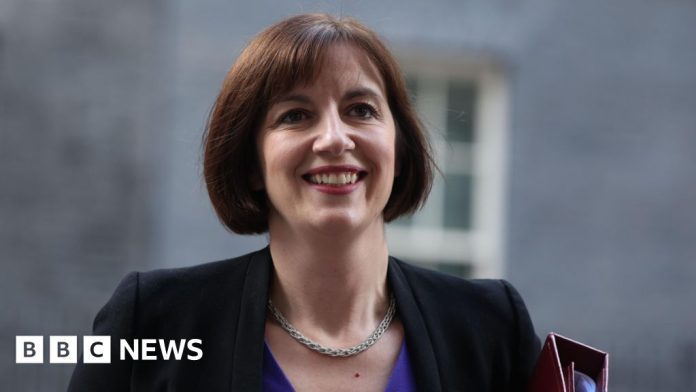Becky Mortonpolitical reporter and
Chris Masonpolitical editor
 EPA/Shutterstock
EPA/ShutterstockBridget Phillipson has become the first Labour deputy leadership contender to gain enough support to run, cementing her place as the early frontrunner.
The education secretary has gained the backing of 116 fellow Labour MPs, clearing the bar of 80 nominations required to progress in the contest.
Former Commons leader Lucy Powell remains her closest rival, having garnered 77 nominations, according to figures released by Labour.
She has opened a clear lead over the remaining three candidates, ahead of the Thursday deadline to secure enough backing.
Bell Ribeiro-Addy has 15 nominations, according to the party, ahead of fellow backbencher Paula Barker on 14, with Foreign Affairs Committee chairwoman Dame Emily Thornberry trailing the pack with 13.
Housing Minister Alison McGovern dropped out of the contest earlier, conceding she was failing to pick up enough support and giving Phillipson her backing.
With many Labour MPs yet to declare their favoured candidate, there is still time for other campaigns to gain momentum.
The candidates have a chance to press their case to colleagues at a virtual hustings taking place on Wednesday evening.
The remaining five hopefuls will be at party headquarters in south London, with Labour MPs able to join remotely to ask questions.
Sir Keir Starmer’s cabinet – which includes 24 MPs – have been told not to nominate any candidate, though junior ministers are able to do so.
But some Labour figures wonder if as many as 80 more could choose not to officially back anyone, shrivelling the electorate.
It looks quite likely Phillipson will stack up a very big number of supporters, further squeezing the remaining votes to be fought over.
As the only member of the cabinet to announce her intention to stand, Phillipson is also expected to be more supportive of the government than some of the other candidates.
This may help her secure lots of MP nominations, but may be a disadvantage if the contest reaches the stage where Labour Party members get a vote and there is a rival candidate not in government.
There is talk among Phillipson’s opponents of the need for votes to consolidate around a viable rival, rather than splinter in five different directions.

Many senior Labour figures have called for the new deputy leader to be a women from northern England, to counter what they see as the London-centric and male-dominated party leadership.
Sir Keir and his new Deputy Prime Minister David Lammy – who replaced Angela Rayner in the role after her resignation last week – both represent London constituencies.
Dame Emily – a London MP – has hit back at the idea the winning candidate should be from outside the capital, suggesting it should be about “what you can do for the party”.
A member of Sir Keir’s frontbench team when the party was in opposition, Dame Emily was a surprise omission from the PM’s cabinet when Labour won power.
Signalling her willingness to challenge the leadership, Dame Emily has pledged to “be a voice for the membership, unions, PLP [Parliamentary Labour Party], and our constituents – not just nod along”.
The tight timetable for the contest has been criticised by some in the party, including Ribeiro-Addy, who has suggested it could prevent left-wing candidates from progressing in the contest.
Although the MP for Clapham and Brixton Hill has acknowledged she is unlikely to win, Ribeiro-Addy said she wanted to use the platform to encourage a debate among Labour members about “what’s gone wrong” in the party’s first year in power.
She cited the government’s position on the war in Gaza and attempts to cut benefits as examples.
Rival candidate Barker has also been critical of the government’s response to the conflict and launching her campaign she called for the party to “go back to our true Labour values”, including to “prioritise people over profit”.
If they secure enough support from their parliamentary colleagues, candidates will then need the backing of either 5% of local parties, or three Labour-affiliated groups, including two unions.
Those who clear the bar face a vote by party members, with the winner announced on 25 October.
Whoever wins the contest, Lammy will remain as deputy prime minister – a role which is appointed by the PM, rather than decided by Labour Party members.
The contest was triggered when Rayner resigned as deputy leader, deputy PM and housing secretary, after admitting she failed to pay enough tax when buying a £800,000 flat in Hove.



